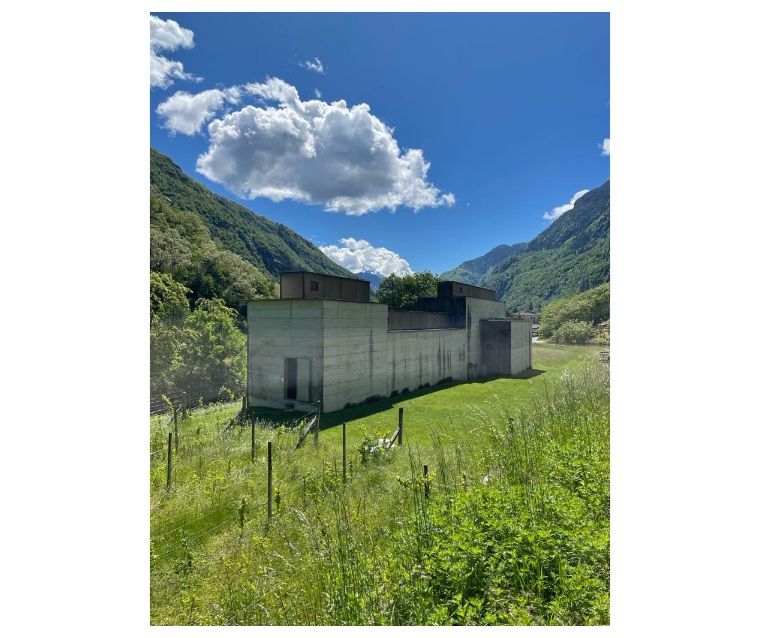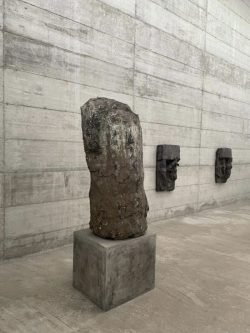
Visiting a relative: Hans Josephsohn in Ticino
20. July 2021Museum buildings that represent a collaboration between artist and architect are very rare. The idea for La Congiunta was born out of the close relationship between sculptor Hans Josephsohn and architect Peter Märkli. According to legend, they had been talking for a long time about a building for Josephsohn’s works and were travelling by train through the Ticino. By chance, they got off the train in Giornico and decided that this was the right place. It’s a village that lies directly south of the Gotthard on the former railway line to the tunnel, a little way from the motorway. It is most notable because of a very rare representation of Trivultus in the Romanesque church of San Nicolao, but beyond that does not invite you to stop. So it was precisely here that the House of Reliefs and Half-Figures by Hans Josephsohn was opened in 1993.
The purpose of La Congiunta Foundation is stated laconically as “Buy a plot of land – build a house – put sculptures inside – leave the door open during the day so that whoever wants to can come in and look. The house displays reliefs and half-figures by Hans Josephsohn (1920–2012), created between 1950 and 2005.”
And so the museum is freely accessible during the day – you pick up the key at the village osteria, walk to the building through a meadow outside the village, and voilà, you enter into this special synergy of sculpture and architecture.
In La Congiunta, thirty-three works by Josephsohn – all of them reliefs and half-figures – are on display, arranged in three oblong rooms and four side chambers. His work is characterised above all by his exploration of the human figure, which is initially depicted in
a reduced form within his oeuvre and then gains in volume over time. Josephsohn worked exclusively with models from his family or close acquaintances, people with whom he was in close contact. His sculptures appear rough, heavy and strong, and yet an original or even existential note becomes apparent in them.[1]
Walking through the three narrow, elongated rooms of La Congiunta, one also examines the development of Josephsohn’s work to a certain extent. Reliefs from his early oeuvre, in which geometric forms still provide a starting point and revolve around the theme of threat, lead on to a more extreme form of thinking, the product of which is a relief in which the pictorial elements project far into the space and gain volume. Here, women are the central figures; the male figures remain on the periphery or are the observers. The female figure is also central to the half-figures, in which the human features seem to emerge from the material only in rudimentary form.
The simultaneous authenticity and hesitancy with which the human features appear or can be guessed at are astonishing. The close connection between material and figure is evident.
It is also remarkable how the impression of the raw and the primordial is reflected in the spaces that form the background to the works. The walls are cast from raw concrete and reflect the rawness. At the same time, the architecture is entirely centred on the works through the unusual proportions of the rooms. As a detail, it should be mentioned that the building has no electricity and no windows, so that only natural light is led into the rooms through light arcades.
The building, which looks a bit like a church because of the four smaller side chambers and its elongated shape – although without giving any impression of the sacred – itself looks like a sculpture in the middle of the landscape. Especially on the approach to the building, the nuances in the form come to light through the different ceiling heights and wall widths. If Josephsohn’s works seek and negotiate the human figure in the primeval, the actual, here we see it enclosed by a building whose subtle simplicity seems just as primeval, marked only by the influence of the weather.
And so, far from thoughts of profitability, this generous museum sits simply in a meadow of flowers, the village nearby, the grotto on the route, and the mountains in the background. We are invited to enjoy this little excursion and walk as something very familiar – it is a visit to the congiunta, the relative.
Fondazione LA CONGIUNTA
Pick up the key at:
Osteria Giornico
Via Stazione Vecchia 2
6745 Giornico
+41 (0)91 864 22 50
[1] It should be briefly noted at this point that, contrary to their effect, the sculptures are not cast in bronze but in brass, a much lighter material.

